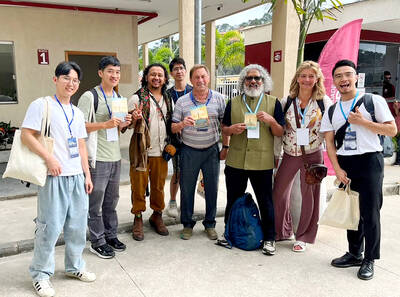Chen Wen-hui (陳文輝) wasted little time when he was put in jail in 1985 for his pro-independence stance. A voracious reader, he absorbed all he could on Taiwan's flora in hopes of creating a bucolic retreat surrounding a wood-fired kiln built for his wife a year before his arrest.
That retreat eventually became Hwataoyao (華陶窯), a tranquil hillside compound where today the Chen family hosts visitors from all over the island. The family has devoted 16 years to building their dreamland, which started in March 1984 when the kiln was established to make flower pots for Chen's wife, in love with the art of flower arrangement.
Since then, the kiln has produced all styles of vessels for flower arrangements as well as containers of all shapes for rice, water, wine or other utensils for daily use. Chen and his wife want Hwataoyao to be characteristic of the land and show a strong flavor that is unique to the place. Chen grows plants and his wife makes pottery, a perfect combination to showcase the countryside's nature and culture.
I met with Chen Yu-ping (陳育平), their daughter, a while back at an exhibition in Taipei and saw the ceramic art of Hwataoyao. With dark hues, thick bodies, and rugged edges, the ceramic products are characteristic of Hwataoyao's old-style craft, one that distinguishes itself from the lighter colored and thinner-shaped ceramics of other countries.
"It's the Miaoli clay and the acacia tree we grow and fire in the kiln that make up what you see today," said Chen's daughter of the rustic ceramics she brought to Taipei. "We want it to be different, having a distinguished look that can be recognized like a trademark in an international exhibition."
Over the years, the name of Hwataoyao has been established and its pottery is now known all over the country, exhibiting in galleries in Taipei and other parts of the island. Chen's daughter invited me to go down to Yuanli to see Hwataoyao for myself, and I gladly accepted.
I took the one day tour and followed guide Liao Chen-an (廖晨安) and a group of visitors on a walking tour of the large compound. Liao, like many of the tour guides, is a local from central Taiwan and is ardent and enthusiastic about linking our daily experience to the plants along the mountain trail.
The botanical park is situated at the back of Hwataoyao, and occupies about three-fourths of the compound. Liao introduced us to the plants growing in the park. One of the first things we saw was giant alocasia. The huge long leaves of the plant were used in the markets to wrap groceries long before plastic bags were introduced to the country, explained Liao. We also saw sapindus mukorosii, whose juice was the shampoo and soap for personal cleaning for the early immigrants.
As we wound up the mountain trail, we saw a forest of acacia trees, which, when fired with the clay, produce beautiful golden and green ash streaks. The tour ended in a forest of trees with blooming white blossoms of phalaenopsis, or butterfly orchid. Wooden tables and chairs and drinks are offered for visitors to rest and appreciate the orchids.
Around noon, we were brought back to the visitor's information center, where we dined in a large hall with views of the countryside. In the afternoon, we met with two masters of Hwataoyao, Chen Sheng-tang (陳升堂) and Chen Chang-pi (陳常碧), both of whom are senior ceramists of Hwataoyao.
They each demonstrated a different technique. Chen Sheng-tang is a master of "small pottery hand," in which he uses a motorized potter's wheel to make smaller pieces of ceramic works. Chen Chang-pi, on the other hand, is dubbed the master of "large pottery hand," in which he uses his hands only to mold the clay into large pieces of pottery, such as wine pots or rice pots. Visitors get to play with the clay, too, if they wish and anyone may have their creation fired in Hwataoyao's kiln for a small fee.
As I talked to Hwataoyao's owner, Chen, and his son-in-law, Wen-lung, I realized that Hwataoyao was not yet a dream fulfilled. "We want butterflies to come in," said Chen, as he offered me tea in his office. "We are researching plants that would attract butterflies and create a natural scene with butterflies flying around in the sky."
An ideal addition to an already beautiful place.

This month the government ordered a one-year block of Xiaohongshu (小紅書) or Rednote, a Chinese social media platform with more than 3 million users in Taiwan. The government pointed to widespread fraud activity on the platform, along with cybersecurity failures. Officials said that they had reached out to the company and asked it to change. However, they received no response. The pro-China parties, the Chinese Nationalist Party (KMT) and Taiwan People’s Party (TPP), immediately swung into action, denouncing the ban as an attack on free speech. This “free speech” claim was then echoed by the People’s Republic of China (PRC),

Most heroes are remembered for the battles they fought. Taiwan’s Black Bat Squadron is remembered for flying into Chinese airspace 838 times between 1953 and 1967, and for the 148 men whose sacrifice bought the intelligence that kept Taiwan secure. Two-thirds of the squadron died carrying out missions most people wouldn’t learn about for another 40 years. The squadron lost 15 aircraft and 148 crew members over those 14 years, making it the deadliest unit in Taiwan’s military history by casualty rate. They flew at night, often at low altitudes, straight into some of the most heavily defended airspace in Asia.

Many people in Taiwan first learned about universal basic income (UBI) — the idea that the government should provide regular, no-strings-attached payments to each citizen — in 2019. While seeking the Democratic nomination for the 2020 US presidential election, Andrew Yang, a politician of Taiwanese descent, said that, if elected, he’d institute a UBI of US$1,000 per month to “get the economic boot off of people’s throats, allowing them to lift their heads up, breathe, and get excited for the future.” His campaign petered out, but the concept of UBI hasn’t gone away. Throughout the industrialized world, there are fears that

The Democratic Progressive Party (DPP) controlled Executive Yuan (often called the Cabinet) finally fired back at the opposition-controlled Legislative Yuan in their ongoing struggle for control. The opposition Chinese Nationalist Party (KMT) and Taiwan People’s Party (TPP) acted surprised and outraged, but they should have seen it coming. Taiwan is now in a full-blown constitutional crisis. There are still peaceful ways out of this conflict, but with the KMT and TPP leadership in the hands of hardliners and the DPP having lost all patience, there is an alarming chance things could spiral out of control, threatening Taiwan’s democracy. This is no